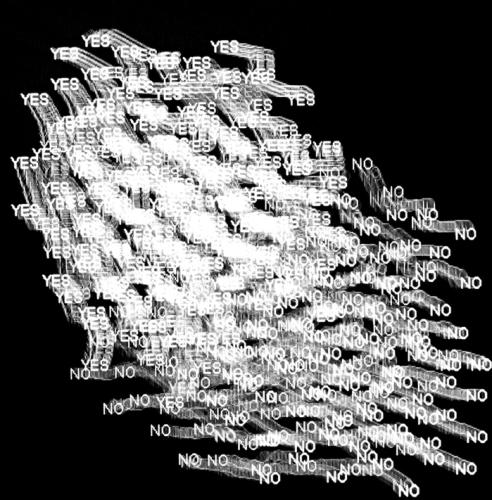Charles Sandison
dal 15/1/2004 al 14/2/2004
Segnalato da
15/1/2004
Charles Sandison
Lisson Gallery, London
Visualising the paradoxical complexities and simplicities of human communication and behaviour, social structures, and Darwinian survival through the use of symbolic language, Sandison's works consist of text, generated by computer software and displayed on screens or projected site specifically onto the walls of the gallery.

Visualising the paradoxical complexities and simplicities of human
communication and behaviour, social structures, and Darwinian survival
through the use of symbolic language, Sandison's works consist of text,
generated by computer software and displayed on screens or projected site
specifically onto the walls of the gallery.
In the work Yes/No, two groups of word types (one of YES, one of NO) are
programmed to repel each other. In the case of a collision, there is a 50/50
chance that either YES will become NO or NO will become YES. The YES words
become more dominant until optimistically eliminate the last NO.
In Tribes, Sandison simulates a sequence of human reproduction and
development from a vocabulary of nine words. Words move in particular and
random ways; the child's movement is confused, mothers are never far behind,
a virus is rapid and unerring. Given sufficient time and space, the
potential exists for the development of complex social units that mimic
patterns of human social behaviour: pairing, reproducing, attacking,
defending or dying.
Charles Sandison's work was first shown at Lisson Gallery in the group show
Wonderful Life in 1993. This is his first solo exhibition at the gallery.
Preview: Friday 16 January, 7-9pm
Gallery Hours: Monday - Friday 10-6, Saturday 11-5
Also at Lisson Gallery, 52-54 Bell Street - Lee Ufan, 21 January - 28
February 2004
LISSON New Space, 29 Bell Street, London, NW1 5DA
T: 00 44 (0)20 7724 2739 F: 00 44 (0)20 7724 7124



